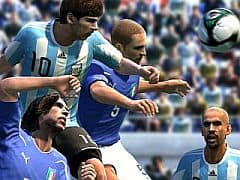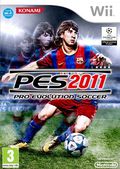You can trust VideoGamer. Our team of gaming experts spend hours testing and reviewing the latest games, to ensure you're reading the most comprehensive guide possible. Rest assured, all imagery and advice is unique and original. Check out how we test and review games here
It’s no secret that I like FIFA more than PES. I have done for a few years, now, ever since EA pulled their finger out and invested in a new game engine and started from scratch. I turned to the dark side, as so many called it, leaving SEABASS and PES behind as they struggled to get to grips with the current generation of consoles. And I haven’t looked back.
But every year some part of me longs for PES to return to its former glory, to improve, to get loads better. And every year I’m disappointed. But this year… this year… things could be different.
Why? Because PES 2011 feels unlike any PES game ever created.
It actually feels a lot like FIFA, which, given how good FIFA is these days, is no bad thing. You have to hold the button down to pass and shoot, bringing up a power bar that governs the weight you put behind a strike of the ball, displayed underneath the player in question.
When it comes to passing, this new manual system means you won’t always hit your target, as has been the case in the past. The direction you press on the analogue stick is where the pass will go, allowing you to play the ball to either the left or right foot, or into space, encouraging the receiver to move away from defenders. This extends to all passes – on the ground, lofted and otherwise – and even throw-ins.
There’s a huge level of adjustment you have to make. I was so used to PES holding my hand that flying solo is initially bewildering. But then, as I began to get to grips with the idea of passing into space at all times, PES11 became liberating. Passing is slick, almost super cool, in a way it hasn’t been in PES for years. Konami reckons it’s so good, it makes the traditional “press triangle to through ball” redundant. I can believe it.
As I nail my first through ball without actually using the through ball button, a defence-splitting pass from flying Chelsea and Ivory Coast winger Salomon Kalou to star striker Didier Drogba, I feel something I haven’t felt while playing a PES game for ages: satisfaction. The ball, now, feels more under my control than I can remember it ever doing. I genuinely feel as if I can make it go where I want. Gone are the invisible track lines that governed PES’ ball physics like sniggering puppeteers. New AI routines mean you’re on your own, and it’s a breath of fresh air.
So pronounced is the change in the basics of gameplay this year that other changes seem insignificant by comparison.
There’s a neat new way of defending that allows you to hold up play, then strike with a well-timed tackle. In practice, this means holding down what initially feels like a complex combination of button presses. The move forces your defender, with his back to goal, to match the running speed of the attacker. Then, when you feel like the time is right, another button press sticks a leg out, hopefully winning the ball. I’d liken it to that iconic Bobby Moore tackle for England against Brazil in the 1970 World Cup.
There’s a new sense of physicality to player collisions – again, aping improvements EA has implemented into FIFA in recent years – which betters the way players jostle for possession of the ball. It’s all stat-based, so Drogba’s going to turf Wright-Phillips off the ball every time, and England captain in all but the armband John Terry will more often than not win a defensive header against Lionel Messi.
The trick system has been completely redone to make it more accessible, and, again, more like FIFA’s. Now, movement of the right thumb stick in combination with the shoulder buttons produces the kinds of tricks the likes of Lionel Messi have copyrighted. You can even chain up to three tricks together, which are mapped to the right stick – brilliantly useful for showing off even if there’s an element of luck to their success, as I suppose there is in real life.
PES Productions, as it’s called, has totally reworked the in-game animations so that players move in a more fluid, natural and realistic fashion. It’s hard to judge the visuals after such a brief showing, but PES11 does look better. I’d say softer, in fact. And it feels slower. Why? It’s due to a combination of factors: the new animations, the new physicality, but most of all the ability to better control the pace of a match with the new manual passing. Because the ball doesn’t ping about like it used to (PES has felt more like an old school arcade football game than a soccer simulation in recent years), you have to be more careful in everything you do. And, as we all know, unless you’re Lionel Messi, being more careful requires more time.
Despite the hundreds of new animations, the visuals lag some way behind FIFA’s. Sure, the player faces – at least the famous ones – look the business, and up close the models look bang on, but when it comes to the in-game view, there’s work to be done to match FIFA’s stunning Super Sunday authenticity. The menus, though, looks loads better. You’ll like them.
In truth, it’s hard to get a handle on PES11 after only 15 minutes spent with the game. So much of the game is yet to be properly revealed: the new “drag and drop” system of team management (which, by the ways, looks great) and the Master League Online (which we know nothing about) are just two areas of interest still unexplored. But I’m confident PES11 is a better PES, and I’m delighted that Konami’s annual “rebuilt from the ground up” claim appears to mean something this time. But critics – particularly FIFA fans – will say Konami is copying its competitor, rather than differentiating itself with never before seen innovations. This is a pill SEABASS will have to live with, but better review scores, as always, help the medicine go down.
PES 2011 is due out for PS3, Xbox 360, PC, Wii, PS2 and PSP this Autumn.
PES 2011
- Platform(s): PC, PlayStation 2, PlayStation 3, PSP, Wii, Xbox 360
- Genre(s): Sport

/https://oimg.videogamer.com/images/1aa5/pes_2011_7.jpg)
/https://oimg.videogamer.com/images/61ca/pes_2011_3.jpg)
/https://oimg.videogamer.com/images/b240/pes_2011_6.jpg)






